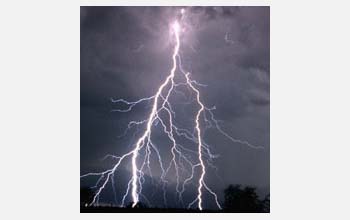|

Press Release 04-129
Midwest Thunderstorm Study Points Toward Better Forecasts


Scientists working on the BAMEX project have discovered new information about how severe storms ...
Credit and Larger Version |
September 30, 2004
Arlington, Va.—Newly documented small-scale circulations embedded in
thunderstorm squall lines not only spew destructive straight-line winds,
but may spawn up to 20% of all U.S. tornadoes. Remnant
circulations from large thunderstorm clusters can survive for days,
triggering new storm cells.
Scientists expect these and other findings to improve forecasts of damaging winds and heavy rain.
The results emerge from three-dimensional portraits of thunderstorms
collected across the stormy Midwest in a field study coordinated
by the National Center for Atmospheric Research (NCAR) in Boulder, Colo. Based just east of St. Louis, the Bow Echo and MCV Experiment (BAMEX)
employed aircraft and ground-based storm chasers to document a wide
range of storm types that prowled the Midwest from May to July 2003. Funding for
the $4 million study was provided by the National Science Foundation (NSF),
NCAR's primary sponsor.
A summary of BAMEX results will be presented on October 5 in Hyannis, Mass., at the
American Meteorological Society's 22nd Conference on Severe Local Storms.
"BAMEX is beginning to yield significant results," says Cliff Jacobs, program director in NSF's division of atmospheric sciences. "The collaborative efforts of many researchers have resulted in new knowledge important to understanding severe storms and the tornadoes they often spawn."
Among the most noteworthy results:
- Size doesn't equal strength when it comes to bow echoes, the
arc-shaped squall lines that produce intense straight-line winds and
spawn dozens of tornadoes each year. "The greatest damage was typically
observed not in the most extensive bow echoes, but in smaller ones
spanning 60 miles or less," says NCAR scientist Christopher Davis,
co-director of BAMEX. Within these small bows, even smaller
circulations appear to focus most of the storm's destructive power and
are the highest risk for tornadoes.
- Mesoscale convective vortices (MCVs)—areas of low pressure similar in
strength and size to weak tropical depressions—extend through a deep
layer of the atmosphere. MCVs, which can trigger several-day rounds
of intense thunderstorms, tend to destabilize the atmosphere as they
pull warm, moist surface air northward, spawning storm after storm as they go.
Scientists from more than a dozen colleges and universities joined NCAR and the National Oceanic and Atmospheric Administration (NOAA) for BAMEX.
-NSF-

Media Contacts
Cheryl Dybas, NSF (703) 292-7734 cdybas@nsf.gov
Anatta , NCAR (303) 497-8604 anatta@ucar.edu
Program Contacts
Cliff Jacobs, NSF (703) 292-8520 cjacobs@nsf.gov

The National Science Foundation (NSF) is an independent federal agency that supports fundamental research and education across all fields of science and engineering. In fiscal year (FY) 2009, its budget is $9.5 billion, which includes $3.0 billion provided through the American Recovery and Reinvestment Act. NSF funds reach all 50 states through grants to over 1,900 universities and institutions. Each year, NSF receives about 44,400 competitive requests for funding, and makes over 11,500 new funding awards. NSF also awards over $400 million in professional and service contracts yearly.
 Get News Updates by Email Get News Updates by Email
Useful NSF Web Sites:
NSF Home Page: http://www.nsf.gov
NSF News: http://www.nsf.gov/news/
For the News Media: http://www.nsf.gov/news/newsroom.jsp
Science and Engineering Statistics: http://www.nsf.gov/statistics/
Awards Searches: http://www.nsf.gov/awardsearch/
| 

